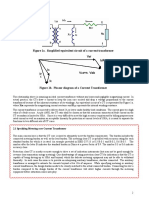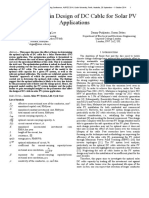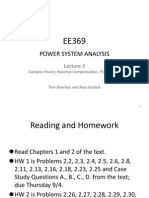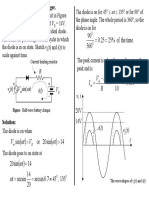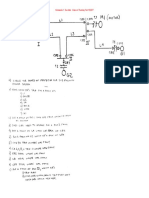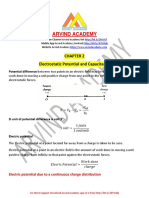Lecture-3
EE 407
Renewable Electrical Energy Resources
Chapter-2
Power System Basics Power Factor Correction
Jameel Ahmad
Department of Electrical Engineering
School of Engineering
University of Management and Technology Lahore
1
�POWER FACTOR CORRECTION
The smaller the p f , the worse the utilization of
power is; the ideal is to get as near as possible
to the perfect p f of 1.0
Sometimes, it is desirable or necessary to use
capacitors to correct the p f to offset the VArs
of the inductive elements
A p f corrective action can lead to the increased
real power delivery to the loads
50
�EXAMPLE: POWER FACTOR CORRECTION
i ( pf < 1 )
i ( pf = 1 )
transformer
with extra
capacity
fully loaded
transformer
load: lagging
pf
load: lagging
pf
pf correction
capacitor
51
�EXAMPLE: POWER FACTOR CORRECTION
A transformer is operating close to its kVA
rating and is used to deliver 600 kVA at a 0.75 p f
There is a 20 % forecasted growth in the real
power demand
This growth needs to be accommodated without
investing in a new transformer by installing
capacitors for p f correction
52
�EXAMPLE: POWER FACTOR CORRECTION
The existing situation is characterized by
p f 0.75
cos
cos 1 0.75 0.72 radians
P 600 0.75
450 kW
Q 600 0.66
397 kVAr
The forecasted situation
Pnew 450 1.2
p f new
540
600
540 kW
0.9
53
�EXAMPLE: POWER FACTOR CORRECTION
cos 1 0.9
0.45 radians
Qnew 600 0.435 261 kVAr
The difference between Q = 476 kVAr and
Qnew = 261 kVAr can be compensated by
capacitors
Qc 476 261 215 kVAr
54
�P = 450 kW
90 kW
before correction
= 0.45
Pnew = 540 kW
Q = 476 kVAr
215 kVAr
capacitor
reactive power
without pf
correction
Q new 261 kVAr
= 0.72
Q = 397 kVAr
anticipated
growth to
720kVA
Q = 476 kVAr
EXAMPLE: POWER FACTOR CORRECTION
with 215-kVAr correction
55
�EXAMPLE: POWER FACTOR CORRECTION
We can determine the capacitance of the p f
correcting capacitors
Q c V c I c V c C Vc
Qc
C
V c2
If we assume that the input voltage to the
capacitors is at 12 kV, then
C
215 kVAr
377 12 kV
2
3.96 10 3 F
56
�DISTRIBUTION SYSTEM CAPACITORS
FOR p f CORRECTION
57
�THE RESIDENTIAL ELECTRICITY SUPPLY
In the US, residential service is typically
provided from a 4.16 kV feeder line through a
step-down transformer to the 120/240 V
household voltage
all outlets provide 120 V
some outlets provide 240 V electricity (air
conditioning, heavier duty appliances)
58
�THE RESIDENTIAL ELECTRICITY SUPPLY
The provision of 240 V service is done by
grounding the center tap of the secondary
side of the transformer
using the other two ends of the windings at
the
120 V supply to obtain the 240 V
potential
59
�THE RESIDENTIAL ELECTRICITY SUPPLY
60
�THE RESIDENTIAL ELECTRICITY SUPPLY
v1 120 2 cos 377 t
v2 120 2 cos 377t
v1 v2 240 2 cos 377t
61
�THE RESIDENTIAL ELECTRICITY SUPPLY
Analytically
v1 t
120 2 cos 377 t
v2 t
120 2 cos 377 t
120 2 cos 377 t
and therefore
v1 t v2 t
240 2 cos 377t
62
�RESIDENTIAL LOAD EXAMPLE
63
�RESIDENTIAL LOAD EXAMPLE
We consider the three loads served by a threewire 120 / 240 V system with
1, 200 W at 120 V on phase A , p f 1.0
2, 400 W at 120 V on phase B , p f 1.0
4, 800 W at 240 V , p f 1.0
We wish to compute the currents in the wires
We start with the relationship
P V I cos V I
64
�RESIDENTIAL LOAD EXAMPLE
For the 4,800 W load
For the 2,400 W load
For the 1,200 W load
65
�RESIDENTIAL LOAD EXAMPLE
Note that KCL induces a current of 10 A in the
neutral leg and therefore the unbalanced load
creates a nonzero current in the neutral
This case differs from the typical balanced
conditions we encounter in which each hot leg
has current of the same magnitude and the
neutral current vanishes
66
�THREE PHASE AC NETWORKS
Todays systems use the three phase
generators to produce electricity and
transmission lines to transport it to various
parts of the network
The interconnection of network elements into a
network is done typically using either the
delta or wye Y configuration
We examine a Yconnected
generator to a
load
67
�THREE PHASE AC NETWORKS
68
�THREE PHASE AC NETWORKS
The phase voltages are measured with respect
to the neutral
where the entities on the right represent the
phasor notation for the voltages
69
�THREE PHASE AC NETWORKS
Note that the voltages are equal in magnitude
and exactly
radians from another (balanced
voltages)
70
�THREE PHASE AC NETWORKS
Consequently,
The voltage between two-phases are typically
called line voltages; for example the line a to the
line b voltage is
and so
71
�THREE PHASE AC NETWORKS
Now, for a balanced network, the phase voltage
r.m.s. values are equal
r.m.s. phase voltage
Therefore
We make use of the identity
72
�THREE PHASE AC NETWORKS
So we obtain
73
�THREE PHASE AC NETWORKS
The relationship of importance for the r.m.s. value
of line-to-line voltage
relative to that of the
phase voltage V p is
Examples of typical values
Vp
service type
buildings
202 V
120 V
commercial
480 V
277 V
residential
416 V
240 V .
74
�THREE PHASE AC NETWORKS
Each phase has apparent power
and so the
system has apparent power
Therefore,
75
�THREE PHASE AC NETWORKS
where
is the phase angle between the phase
current and the voltage and is identical for each
phase under balanced conditions
In fact, we can show that
and is constant and such a smooth constant level
of power constitutes a key advantage of
tems in contrast to
where
sys-
is sinusoidal
76
�THREE PHASE AC NETWORKS
power
total power pa pb pc is constant
average power in pa , pb or pc
pa
pb
pc
77
�EXAMPLE:
The
using a
NETWORK p f CORRECTION
motors in a small enterprise are supplied
208 V transformer
The real power demand is 80 kW with a p f = 0.5
and incurs losses of 4 kW
We compute
using
so that
78
�EXAMPLE:
NETWORK p f CORRECTION
We also evaluate
Next consider a p f correction to 0.9 and so
79
�EXAMPLE:
NETWORK p f CORRECTION
Also
We also evaluate the losses under corrected pf
80
�THE
DELTA CONNECTION
The other way to connect
elements in the
connection which has no neutral line
81
�THE
DELTA CONNECTION
The comparison of the key characteristics of the
two connection schemes is summarized by the
table
variable
r.m.s. current
r.m.s. voltage
power
P3 3 V p I p cos
82











